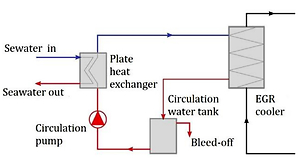Current issue
Online first
Archive
About the Journal
Aims and scope
Publisher and Editorial
Advertising policy
For Authors
Paper review procedures
Procedures protecting authentic authorship of papers
Paper preparation manual
Plagiarism check
Publication ethics
Reviewers
APC
Editorial and Scientific Board
Contact
Reviewers
Comparative analysis of the heat balance results of the selected Tier III-compliant gas-fuelled two-stroke main engines
1
Doctoral School of the Maritime University of Szczecin, Maritime University of Szczecin, Poland
Submission date: 2022-09-04
Final revision date: 2022-11-24
Acceptance date: 2022-12-25
Online publication date: 2023-01-03
Publication date: 2023-06-14
Corresponding author
Piotr Kamil Korlak
Doctoral School of the Maritime University of Szczecin, Maritime University of Szczecin, Poland
Doctoral School of the Maritime University of Szczecin, Maritime University of Szczecin, Poland
Combustion Engines 2023,193(2), 24-28
KEYWORDS
TOPICS
ABSTRACT
Two-stroke engines are distinguished by the highest overall efficiency among all main engines. This is not only due to the low speed, and large piston stroke, but also to the high combustion temperature, which result in an increase in nitrogen oxides (NOx) emission. Technical solutions applied to bring main engines into compliance with current NOx emission standards set by the Tier III limits include the use of SCR and EGR systems, the implementation of the Otto cycle, and the application of liquified natural gas (LNG) as the low-emission fuel. Impact of the available Tier III-compliant technologies on the heat balance results is analysed using the example of the currently most popular dual-fuel main engines, i.e. WinGD X92DF and MAN G95ME-C10.5-GI. The possibilities of waste heat recovery in the electricity generation process and thereby improving the ship energy efficiency are discussed.
REFERENCES (24)
1.
Andreasen JG, Meroni A, Haglind F. A comparison of organic and steam Rankine cycle power systems for waste heat recovery on large ships. Energies. 2017;(10):547. https://doi.org/10.3390/en1004....
2.
Brzeżański M, Mężyk P. Heat balance of the military vehicle. Combustion Engines. 2017;170(3):131-134. https://doi.org/10.19206/CE201....
3.
Hochgreb S. Handbook of Air Pollution from Internal Combustion Engines. Academic Press. San Diego 1998.
4.
International Maritime Organisation. IMO Train the Trainer (TTT) Course on Energy Efficient Ship Operation, Module 2 – Ship Energy Efficiency Regulations and Related Guidelines. https://www.imo.org/en/OurWork... (accessed on 24.11.2022).
5.
Ivanova G. Analysis of the specifics in calculating the index of existing marine energy efficiency EEXI in force since 2023. 2021 13th Electrical Engineering Faculty Conference. 2021:1-4. https://doi.org/10.1109/BulEF5....
6.
Kniaziewicz T, PiasecznyL. Selected aspects of application of dual fuel marine engines. Combustion Engines. 2021;148(1):25-34. https://doi.org/10.19206/CE-11....
7.
Korlak PK. Prediction of the ultra-large container ships’ propulsion power at the initial design stage. Communications – Scientific Journals of the University of Zilina. 2022;24(3):228-238. https://doi.org/10.26552/com.C....
8.
Korlak PK. Prediction of the very- and ultra-large container ships’ electricity generation capacity at the initial design stage. Naše More. 2022;69(2):103-113. https://doi.org/10.17818/NM/20....
9.
Krakowski R. The emissions reduction possibility of sulphur compounds of vessel sailing in Emission Control Area (ECA). Combustion Engines. 2017;169(2):162-166. https://doi.org/10.19206/CE-20....
10.
Latarche M. Pounder’s marine diesel engines and gas turbines.Tenth edition. Elsevier Science. Oxford 2020.
11.
Liberacki R. Niekonwencjonalne metody odzysku ciepła odpadowego na statkach. Journal of Polish CIMEEAC. 2019;(14). http://www.polishcimeeac.pl/Pa....
12.
MAN Diesel & Turbo. Costs and benefits of LNG as ship fuel for container vessels. Copenhagen 2013.
14.
MAN Diesel & Turbo. Waste Heat Recovery System (WHRS) for reduction of fuel consumption, emissions and EEDI. Copenhagen 2017.
16.
Molland AF. The Maritime Engineering Reference Book. Elsevier Science. Oxford 2008.
17.
Mondejar ME, Andreasen JG, Pierobon L, Larsen U, Thern M, Haglind F. A review of the use of organic Rankine cycle power systems for maritime applications. Renew Sust Energ Rev. 2018;(91):126-151. https://doi.org/10.1016/j.rser....
18.
Sagin S, Kuropyatnyk O, Sagin A, Tkachenko I, Fomin O, Píštěk V, Kučera P. Ensuring the Friendliness of Drillships during Their Operation in Special Ecological Regions of Northern Europe. J Mar Sci Eng. 2022;(10):1331. https://doi.org/10.3390/jmse10....
19.
Singh DV, Pedersen E, A review of waste heat recovery technologies for maritime applications. Energ Convers Manage.2016;(111):315-328. https://doi.org/10.1016/j.enco....
20.
Szelangiewicz T, Żelazny K. CO2 emission level as a criterion in modern transport ship design. Combustion Engines. 2014;156(1):59-68. https://doi.org/10.19206/CE-11....
24.
Wojnowski W. Okrętowe siłownie spalinowe. Cz. I. Wydawnictwo Akademii Marynarki Wojennej w Gdyni. Gdynia 1998.
CITATIONS (2):
1.
Complex Use of the Main Marine Diesel Engine High- and Low-Temperature Waste Heat in the Organic Rankine Cycle
Sergejus Lebedevas, Tomas Čepaitis
Journal of Marine Science and Engineering
Sergejus Lebedevas, Tomas Čepaitis
Journal of Marine Science and Engineering
2.
Utilization of waste heat and cold on the example of an LNG-fueled ultra-large container ship
Piotr Korlak, Ewelina Złoczowska, Cezary Behrendt
Energy Reports
Piotr Korlak, Ewelina Złoczowska, Cezary Behrendt
Energy Reports
We process personal data collected when visiting the website. The function of obtaining information about users and their behavior is carried out by voluntarily entered information in forms and saving cookies in end devices. Data, including cookies, are used to provide services, improve the user experience and to analyze the traffic in accordance with the Privacy policy. Data are also collected and processed by Google Analytics tool (more).
You can change cookies settings in your browser. Restricted use of cookies in the browser configuration may affect some functionalities of the website.
You can change cookies settings in your browser. Restricted use of cookies in the browser configuration may affect some functionalities of the website.



